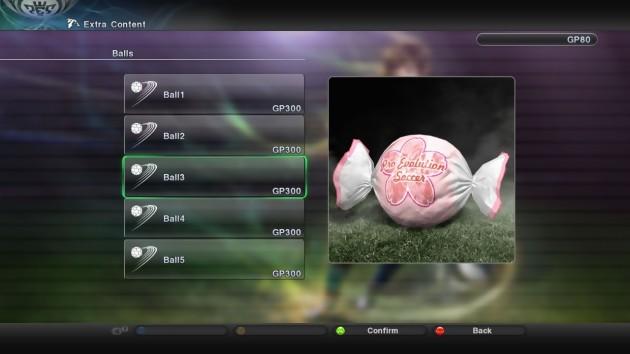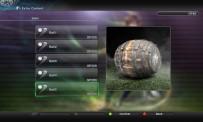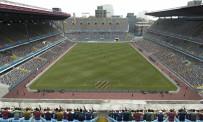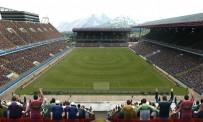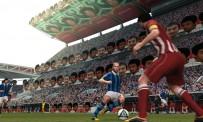 Welcome to the menus of PES 2011. "Exhibition", "Master League", "UEFA Champion's League", "Towards a legend", "League/Cup", "Online game", we are entitled to the great classic. Only the Copa Libertadores appears to be the only novelty in terms of game modes, which will allow a kind of C1 to be played, this time bringing together the best clubs in South America. By taking a look in the Training menu, we realize that the developers have decided to make it much more ergonomic thanks to drag & drop. Indeed, a snap of the fingers, it is possible to change the position of a player without burning the brain. In a few seconds, we went from the Spanish 4-3-3 to a 4-2-3-1 with Xavi and Fabregas in charge, Iniesta on the left, Silva on the right, Torres in the lead and Villa in support. It's simple and instinctive. As in Pro Evolution Soccer 2010, player positioning will have a direct impact on their performance. Xavi and Fabregas, for example, will be much more comfortable in the position of torchbearer (MR) than in defensive midfielder (Mdf). It seems like a long time ago when we played with Roberto Carlos as a left winger…! As usual, we can choose game mentalities that can be activated during the match (offensive or defensive possession, attack on the left, on the right, counter-attack...), and adjust some parameters that will determine the behavior of the players on the ground. Positioning of the team block, height of pressing, defensive largesse or support distance will be taken into account in the management of matches. Better still, all these settings can be anticipated in terms of coaching. More concretely, in the case where we lead fairly quickly to the score, we can ask the players from the 30th minute to play only against. Then, in the second half, to take care of the retention of the ball and the long game. If the opponent returns to the score, we can always opt for an "all for the attack" and bring up the central defenders. In short, PES 2011 offers the opportunity to put on the coaching costume and change the tactics of his team at any time during the game. Part, let's talk about it a bit. As specialists often say, "only the truth on the ground counts".
Welcome to the menus of PES 2011. "Exhibition", "Master League", "UEFA Champion's League", "Towards a legend", "League/Cup", "Online game", we are entitled to the great classic. Only the Copa Libertadores appears to be the only novelty in terms of game modes, which will allow a kind of C1 to be played, this time bringing together the best clubs in South America. By taking a look in the Training menu, we realize that the developers have decided to make it much more ergonomic thanks to drag & drop. Indeed, a snap of the fingers, it is possible to change the position of a player without burning the brain. In a few seconds, we went from the Spanish 4-3-3 to a 4-2-3-1 with Xavi and Fabregas in charge, Iniesta on the left, Silva on the right, Torres in the lead and Villa in support. It's simple and instinctive. As in Pro Evolution Soccer 2010, player positioning will have a direct impact on their performance. Xavi and Fabregas, for example, will be much more comfortable in the position of torchbearer (MR) than in defensive midfielder (Mdf). It seems like a long time ago when we played with Roberto Carlos as a left winger…! As usual, we can choose game mentalities that can be activated during the match (offensive or defensive possession, attack on the left, on the right, counter-attack...), and adjust some parameters that will determine the behavior of the players on the ground. Positioning of the team block, height of pressing, defensive largesse or support distance will be taken into account in the management of matches. Better still, all these settings can be anticipated in terms of coaching. More concretely, in the case where we lead fairly quickly to the score, we can ask the players from the 30th minute to play only against. Then, in the second half, to take care of the retention of the ball and the long game. If the opponent returns to the score, we can always opt for an "all for the attack" and bring up the central defenders. In short, PES 2011 offers the opportunity to put on the coaching costume and change the tactics of his team at any time during the game. Part, let's talk about it a bit. As specialists often say, "only the truth on the ground counts".
As in Pro Evolution Soccer 2010, player positioning will have a direct impact on their performance. Xavi and Fabregas, for example, will be much more comfortable in the torchbearer position than in defensive midfield."
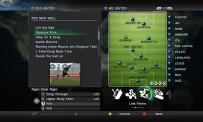 In terms of production, it starts badly. The stadium seems all flat, all empty, all grey. Not a single tifo, no flags, and it looks like confetti has been banned from Pro Evolution Soccer 2011. It must be said that we have dabbled a bit in the FIFA World Cup: South Africa 2010 in the meantime, and that it was rather festive in its coating. And there, the shock is severe. It feels more like a stadium in an Eastern country for a second round of the Europa League. The environment has never been one of the strong points of the saga, but still, we expected the Seabass teams to let go a little more. Never mind. Second black point: the comments of Grégoire Margotton and Christophe Dugarry still as uninspired, always behind the action, in short, totally in accordance with the great PES tradition. We will end up thinking that Konami considers bad comments as an essential trademark. On the other hand, the modeling of the players is excellent. Our billionaires in shorts are glaringly realistic, all of them. Puyol, Robben, Xavi, Casillas, Van Persie or even Kuyt to name a few are immediately recognizable, even for those who have only seen them on a Panini sticker. Likewise, the shirts are still as well made and do not suffer from the "cardboard" effect of FIFA. If the stadiums are sober, the players are veritable mines of polygons. Since we have to talk about the feelings of the game and the gameplay, a first observation is essential: like FIFA 11, the pace of the game has been slowed down. The matches thus become more posed, more "tactical" and the supersonic passes are no longer really relevant. However, it should be noted that the player will be able to adjust the speed of the game himself. From -2 to +2, this speed gauge heavily claimed by fans will satisfy everyone. On our side, the basic setting on 0 or -1 is the one that seemed the most adequate to us. To speak a little about the animation of the players, nothing to say, PES buries the competition. Our virtual footballers have a wide range of movements, particularly striking. We feel that all the members of their bodies react to the sequence in a natural way (the bust anticipates the movement of the pelvis which anticipates the movement of the legs) and the players do not give the impression, as in FIFA, of having a handle broom in the foundation. They perform their gestures much less robotically than before. It is therefore useless to hope that one of them goes from 0 to 25 km/h in two strides, since all the movements are broken down. Control, orientation of the body and the ball, acceleration, nothing has been forgotten.
In terms of production, it starts badly. The stadium seems all flat, all empty, all grey. Not a single tifo, no flags, and it looks like confetti has been banned from Pro Evolution Soccer 2011. It must be said that we have dabbled a bit in the FIFA World Cup: South Africa 2010 in the meantime, and that it was rather festive in its coating. And there, the shock is severe. It feels more like a stadium in an Eastern country for a second round of the Europa League. The environment has never been one of the strong points of the saga, but still, we expected the Seabass teams to let go a little more. Never mind. Second black point: the comments of Grégoire Margotton and Christophe Dugarry still as uninspired, always behind the action, in short, totally in accordance with the great PES tradition. We will end up thinking that Konami considers bad comments as an essential trademark. On the other hand, the modeling of the players is excellent. Our billionaires in shorts are glaringly realistic, all of them. Puyol, Robben, Xavi, Casillas, Van Persie or even Kuyt to name a few are immediately recognizable, even for those who have only seen them on a Panini sticker. Likewise, the shirts are still as well made and do not suffer from the "cardboard" effect of FIFA. If the stadiums are sober, the players are veritable mines of polygons. Since we have to talk about the feelings of the game and the gameplay, a first observation is essential: like FIFA 11, the pace of the game has been slowed down. The matches thus become more posed, more "tactical" and the supersonic passes are no longer really relevant. However, it should be noted that the player will be able to adjust the speed of the game himself. From -2 to +2, this speed gauge heavily claimed by fans will satisfy everyone. On our side, the basic setting on 0 or -1 is the one that seemed the most adequate to us. To speak a little about the animation of the players, nothing to say, PES buries the competition. Our virtual footballers have a wide range of movements, particularly striking. We feel that all the members of their bodies react to the sequence in a natural way (the bust anticipates the movement of the pelvis which anticipates the movement of the legs) and the players do not give the impression, as in FIFA, of having a handle broom in the foundation. They perform their gestures much less robotically than before. It is therefore useless to hope that one of them goes from 0 to 25 km/h in two strides, since all the movements are broken down. Control, orientation of the body and the ball, acceleration, nothing has been forgotten.
Canal + Football Club
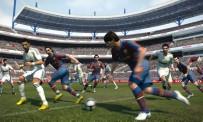 Konami didn't lie to us and the first sequences are done tentatively; proof that you have to relearn everything in PES 2011. As we already explained in our preview, all assists present in previous seasons have been removed. Initially, totally left to himself, the player must therefore show the greatest application to dose passes, strikes, checks and dribbles which will all be subject to the dictates of a gauge that he will have to learn to master. By pressing cross too softly, the ball will not reach the partner. Conversely, pressing too hard will send the ball into the stands. At first, fans of the series will find it difficult to get used to it, such a dosage in the passes not having often existed in PES. As Jean-Michel Larqué often repeats, it's the free space that indicates the place where you have to play; and we quickly understand that with Cross and Triangle, we can really orient the game as we wish and build actions worthy of the most beautiful phases of play by Vincente Del Bosque's team. The first actions are however not very convincing, and the old reflexes do not seem to lead to much. One in particular seems completely obsolete: the multiplication of one-twos which once made it possible to go up the field in three touches of the ball and to erase opposing defenders 40 meters from their goals. In PES 2011, a one-two is only effective in the last 30 yards. No way like in FIFA 10 to leave half of the opposing team behind with a through pass. Konami had the good idea to completely rethink the AI tusks for our greatest pleasure. Applied in their placement, fast, lucid, the defenders very rarely find themselves in holes. Attackers and midfielders, meanwhile, will take care to withdraw in the defensive phase and it will therefore be impossible for a goalkeeper to find himself abandoned by his rearguard. No more fatal counters that end in an annoying two against one. Likewise, the good old technique of overflow and back pass, as much to say it right away, is a thing of the past – Laurely is not ready to plant a goal. To score, it will be a question of patiently building, rotating, temporizing, waiting for the right moment to create the shift that will allow you to get into a striking position. You will have to be altruistic, but also take your chance when the opportunity arises. Nothing is decided in advance, because we can very well succeed in a powerful strike from 25 meters (with Silva, from the left, for example), just before missing a face-to-face with Torres. The game encourages risk-taking, to attempt sequences even in situations that are not really obvious, which means that no goal will look like another and that uncertainty will be permanent. A feeling that we had forgotten by dint of playing titles where everything had become predictable.
Konami didn't lie to us and the first sequences are done tentatively; proof that you have to relearn everything in PES 2011. As we already explained in our preview, all assists present in previous seasons have been removed. Initially, totally left to himself, the player must therefore show the greatest application to dose passes, strikes, checks and dribbles which will all be subject to the dictates of a gauge that he will have to learn to master. By pressing cross too softly, the ball will not reach the partner. Conversely, pressing too hard will send the ball into the stands. At first, fans of the series will find it difficult to get used to it, such a dosage in the passes not having often existed in PES. As Jean-Michel Larqué often repeats, it's the free space that indicates the place where you have to play; and we quickly understand that with Cross and Triangle, we can really orient the game as we wish and build actions worthy of the most beautiful phases of play by Vincente Del Bosque's team. The first actions are however not very convincing, and the old reflexes do not seem to lead to much. One in particular seems completely obsolete: the multiplication of one-twos which once made it possible to go up the field in three touches of the ball and to erase opposing defenders 40 meters from their goals. In PES 2011, a one-two is only effective in the last 30 yards. No way like in FIFA 10 to leave half of the opposing team behind with a through pass. Konami had the good idea to completely rethink the AI tusks for our greatest pleasure. Applied in their placement, fast, lucid, the defenders very rarely find themselves in holes. Attackers and midfielders, meanwhile, will take care to withdraw in the defensive phase and it will therefore be impossible for a goalkeeper to find himself abandoned by his rearguard. No more fatal counters that end in an annoying two against one. Likewise, the good old technique of overflow and back pass, as much to say it right away, is a thing of the past – Laurely is not ready to plant a goal. To score, it will be a question of patiently building, rotating, temporizing, waiting for the right moment to create the shift that will allow you to get into a striking position. You will have to be altruistic, but also take your chance when the opportunity arises. Nothing is decided in advance, because we can very well succeed in a powerful strike from 25 meters (with Silva, from the left, for example), just before missing a face-to-face with Torres. The game encourages risk-taking, to attempt sequences even in situations that are not really obvious, which means that no goal will look like another and that uncertainty will be permanent. A feeling that we had forgotten by dint of playing titles where everything had become predictable.
To score, it will be a question of building patiently, of rotating, of delaying, of waiting for the right moment to create the gap which will allow you to put yourself in a striking position.
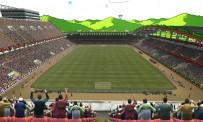 One thing is certain: the main concern of the Seabass development teams was to completely rethink the gameplay of their title. One of the first consequences of this choice is that on the side of the offline game modes, things remain practically similar to PES 2010, as we have already pointed out a little higher. Customization occupies an important place in the game, as evidenced by the Modify menu where we note the presence of a stadium editor. In the same way that we can create a player from scratch, it is now possible to edit an arena from A to Z, from the shape of the stands to the color of the lawn, including the design of the benches. Totally useless but nice. Since we are in the personalization aspect, you should also know that PES 2011 gives access to a creator of feints and dribbles. Don't expect a real alien hook lab though, it's actually about assigning specific commands to various feints offered in the game. No need therefore to spend hours learning all the key combinations necessary to perform dribbles since in a few minutes, you can configure your controller with the movements of your choice. If you want to chain a roulette wheel, a stepover, a hook and a Ronaldinho-style flip-flop by pressing "up" four times with the right stick, no problem. Only downside - but it may be due to our way of playing - all these feints and other dribbles seemed totally useless once on the field. Like Cristiano Ronaldo's charms, those of Pro Evolution Soccer 2011 are very pretty on slow motion, but in terms of efficiency and interest, it's zero points. However, this option should certainly delight fans of knitting. Naturally equipped with an online mode, the game allows you to play a Master League online (MLO). How does it happen ? It's quite simple. As locally, it is a question of choosing a team, players and chaining the matches. A system of divisions has also been put in place, reminiscent of that of the FIFA World Cup: South Africa 2010. To participate in a competition, it is necessary to pay an access fee. Except that this price varies according to the quality of his team. A dream team comprising Messi, Sneijder, Robben, Klose and Drogba will require much more expense than a less posh formation. And in case of defeat, the losses will sometimes be so heavy that it will be necessary to sell one or two players to get out of the red. Moreover, we will also notice that the cost of the players will vary according to their popularity. If a lot of gamers registered on the MLO buy in mass from the same footballer, the price of this one will skyrocket. It is therefore essential to play the Arsène Wenger and to make your recruiter work so that he finds young hopefuls with great potential, or on the contrary, old veterans at the end of their career who can help out for a season.
One thing is certain: the main concern of the Seabass development teams was to completely rethink the gameplay of their title. One of the first consequences of this choice is that on the side of the offline game modes, things remain practically similar to PES 2010, as we have already pointed out a little higher. Customization occupies an important place in the game, as evidenced by the Modify menu where we note the presence of a stadium editor. In the same way that we can create a player from scratch, it is now possible to edit an arena from A to Z, from the shape of the stands to the color of the lawn, including the design of the benches. Totally useless but nice. Since we are in the personalization aspect, you should also know that PES 2011 gives access to a creator of feints and dribbles. Don't expect a real alien hook lab though, it's actually about assigning specific commands to various feints offered in the game. No need therefore to spend hours learning all the key combinations necessary to perform dribbles since in a few minutes, you can configure your controller with the movements of your choice. If you want to chain a roulette wheel, a stepover, a hook and a Ronaldinho-style flip-flop by pressing "up" four times with the right stick, no problem. Only downside - but it may be due to our way of playing - all these feints and other dribbles seemed totally useless once on the field. Like Cristiano Ronaldo's charms, those of Pro Evolution Soccer 2011 are very pretty on slow motion, but in terms of efficiency and interest, it's zero points. However, this option should certainly delight fans of knitting. Naturally equipped with an online mode, the game allows you to play a Master League online (MLO). How does it happen ? It's quite simple. As locally, it is a question of choosing a team, players and chaining the matches. A system of divisions has also been put in place, reminiscent of that of the FIFA World Cup: South Africa 2010. To participate in a competition, it is necessary to pay an access fee. Except that this price varies according to the quality of his team. A dream team comprising Messi, Sneijder, Robben, Klose and Drogba will require much more expense than a less posh formation. And in case of defeat, the losses will sometimes be so heavy that it will be necessary to sell one or two players to get out of the red. Moreover, we will also notice that the cost of the players will vary according to their popularity. If a lot of gamers registered on the MLO buy in mass from the same footballer, the price of this one will skyrocket. It is therefore essential to play the Arsène Wenger and to make your recruiter work so that he finds young hopefuls with great potential, or on the contrary, old veterans at the end of their career who can help out for a season.
We are replaying the match
 Despite all these qualities listed, some imperfections remain in PES 2011. Less than in previous years, of course, but still we would have liked not to have to highlight them. First of all, it should be noted that some actions unfortunately remain "cracked". For example, if you manage to overflow on the side in the idea of crossing, there is a good chance that the action will go to the end. Irreproachable on the ground, defenses and goalkeepers are irremediably more cautious when playing in the air. It is therefore quite common for attackers to find the opposing nets with a furious headbutt in the leather, following a center (always) millimeter. In the same way, we can be certain that if we obtain a free kick at the entrance to the surface, the ball ends up at the back of the opponent's cage. Indeed, the goalkeeper tends to systematically push the ball back at an opposing player following a strong strike, and as the goal is wide open just behind... Even easier than a penalty. Moreover, since we are talking about penalties, we wonder why the camera is placed at the level of the stands, instead of passing behind the player as has been the case since the dawn of time - knowing that this only concerns penalties whistled in the middle of a match. Result of the races: even after more than a hundred matches, we still haven't managed to plant a peno. Frustrating. Another defect with which you will have to learn to play: the annoying habit that referees have of whistling every 30 seconds, as soon as you manage to steal a ball from an opponent with a little virility. Not that we are followers of lax English-style refereeing, where you really have to tear off half of an opponent's leg so that the man in black does not get the card, but it seems to us that a middle ground could have been found. Especially since, without falling into paranoia, only our own faults were whistled, which can sometimes make matches frustrating. Another defect: the management of the change of player. Always assigned to L1 when you don't have the ball, the latter seemed very approximate to us, and more particularly during the defensive phases, since it often happens that the ball ends up between three players and that you don't can take control of any of them.
Despite all these qualities listed, some imperfections remain in PES 2011. Less than in previous years, of course, but still we would have liked not to have to highlight them. First of all, it should be noted that some actions unfortunately remain "cracked". For example, if you manage to overflow on the side in the idea of crossing, there is a good chance that the action will go to the end. Irreproachable on the ground, defenses and goalkeepers are irremediably more cautious when playing in the air. It is therefore quite common for attackers to find the opposing nets with a furious headbutt in the leather, following a center (always) millimeter. In the same way, we can be certain that if we obtain a free kick at the entrance to the surface, the ball ends up at the back of the opponent's cage. Indeed, the goalkeeper tends to systematically push the ball back at an opposing player following a strong strike, and as the goal is wide open just behind... Even easier than a penalty. Moreover, since we are talking about penalties, we wonder why the camera is placed at the level of the stands, instead of passing behind the player as has been the case since the dawn of time - knowing that this only concerns penalties whistled in the middle of a match. Result of the races: even after more than a hundred matches, we still haven't managed to plant a peno. Frustrating. Another defect with which you will have to learn to play: the annoying habit that referees have of whistling every 30 seconds, as soon as you manage to steal a ball from an opponent with a little virility. Not that we are followers of lax English-style refereeing, where you really have to tear off half of an opponent's leg so that the man in black does not get the card, but it seems to us that a middle ground could have been found. Especially since, without falling into paranoia, only our own faults were whistled, which can sometimes make matches frustrating. Another defect: the management of the change of player. Always assigned to L1 when you don't have the ball, the latter seemed very approximate to us, and more particularly during the defensive phases, since it often happens that the ball ends up between three players and that you don't can take control of any of them.
Another flaw with which you will have to learn to play: the annoying habit that referees have of whistling every 30 seconds, as soon as you manage to steal a ball from an opponent with a little virility.
 But the big "flaw" of the game, if we can call it that, is that even more than the strategy, the composition of your team or the match sheet, what will play the most in PES 2011 is the form of the players. It will be nice to have Robinho in his team, if the latter does not have at least the green arrow, he will rather play like Michel Robigneau, substitute winger of the Sports Association of Trifouilli the two churches. As long as in the Master League, C1 and consort the players have a little morale in the socks, we will witness peaks of video game boredom, where even a Barcelona-Inter Milan will take forms of the first round of the Pitch Cup. Worse still: in solo, it is very difficult to take pleasure on this PES 2011 without playing with a team of a high level. Just for fun, we tried to have a Master League season with the TFC. The catastrophe ! So yes, these parts will seem devilishly realistic for all Ligue 2 subscribers. But for fun, we'll come back. Therefore, we can seriously ask ourselves the question: what is the point of pushing the realism of a game so far, if it is for the end that one out of two matches turns out to be as deadly boring as a Brest-Le Havre in November? And this is perhaps the main concern of this PES 2011, the one that will certainly make many players end up sulking; okay we've never seen such a realistic simulation, but it's probably for a good reason. Who wants to rediscover, joystick in hand, the frustration of the musty match where the players multiply the approximations, where each game action seems to go at two times an hour, where each shot on goal systematically goes into the stands, in short, where each movement is marked with the seal of this footballing mediocrity that we point the finger at every weekend while watching our dear L1 Orange? Not many people indeed, if not a few fierce pad who only take pleasure when they feel frustrated. So of course, these are only certain matches, with certain teams, in very specific situations. Needless to say, Sunday players - those who soon put all the arrows in red and only play with Barca, Inter, Chelsea or Real - will probably never realize what problem. But for the others, those who like to play with something other than big cars, the situation will be really different. Those will certainly say that even if it means paying 70€ to see shin checks and unscrewed strikes in a dreary stadium and without any tifo, you might as well go to the Parc des Princes!
But the big "flaw" of the game, if we can call it that, is that even more than the strategy, the composition of your team or the match sheet, what will play the most in PES 2011 is the form of the players. It will be nice to have Robinho in his team, if the latter does not have at least the green arrow, he will rather play like Michel Robigneau, substitute winger of the Sports Association of Trifouilli the two churches. As long as in the Master League, C1 and consort the players have a little morale in the socks, we will witness peaks of video game boredom, where even a Barcelona-Inter Milan will take forms of the first round of the Pitch Cup. Worse still: in solo, it is very difficult to take pleasure on this PES 2011 without playing with a team of a high level. Just for fun, we tried to have a Master League season with the TFC. The catastrophe ! So yes, these parts will seem devilishly realistic for all Ligue 2 subscribers. But for fun, we'll come back. Therefore, we can seriously ask ourselves the question: what is the point of pushing the realism of a game so far, if it is for the end that one out of two matches turns out to be as deadly boring as a Brest-Le Havre in November? And this is perhaps the main concern of this PES 2011, the one that will certainly make many players end up sulking; okay we've never seen such a realistic simulation, but it's probably for a good reason. Who wants to rediscover, joystick in hand, the frustration of the musty match where the players multiply the approximations, where each game action seems to go at two times an hour, where each shot on goal systematically goes into the stands, in short, where each movement is marked with the seal of this footballing mediocrity that we point the finger at every weekend while watching our dear L1 Orange? Not many people indeed, if not a few fierce pad who only take pleasure when they feel frustrated. So of course, these are only certain matches, with certain teams, in very specific situations. Needless to say, Sunday players - those who soon put all the arrows in red and only play with Barca, Inter, Chelsea or Real - will probably never realize what problem. But for the others, those who like to play with something other than big cars, the situation will be really different. Those will certainly say that even if it means paying 70€ to see shin checks and unscrewed strikes in a dreary stadium and without any tifo, you might as well go to the Parc des Princes!
